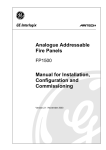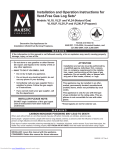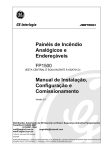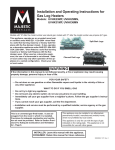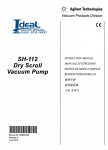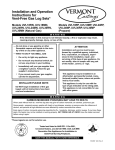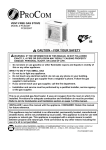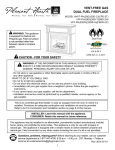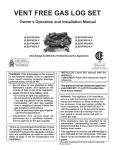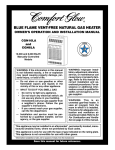Download Vermont Casting UC241L User's Manual
Transcript
Installation and Operating Instructions for Unvented Gas Log Heaters DE S I GN CE RTIFI E D Thermstatically Controlled Double Burner Certified to ANSI Z21.11.2A Models: UC181N, UE181N, UC241N, UE241N (Natural Gas) UC181L, UE181L, UC241L, UE241L (Propane) Standard Decorative Gas Appliance For Installation In Solid Fuel Burning Fireplaces WARNING If the information in this manual is not followed exactly, a fire or explosion may result causing property damage, personal injury or loss of life. ATTENTION — Do not store or use gasoline or other flammable vapors and liquids in the vicinity of this or any other appliance. — WHAT TO DO IF YOU SMELL GAS • Do not try to light any appliance. • Do not touch any electrical switch; do not use any phone in your building. • Immediately call your gas supplier from a neighbor’s phone. Follow the gas supplier’s instructions. • If you cannot reach your gas supplier, call the fire department. Installation, service, and repair of this appliance must be performed by a qualified installer, service agency, company or gas supplier experienced with this type of gas appliance. INSTALLER: Read these instructions completely and carefully prior to beginning installation. The installer should initiate the startup procedure and operate the gas log heater for a minimum of 15-30 minute test burn. After installation, leave these instructions with the owner. OWNER: WARNING This appliance is for installation in a a solid fuel burning fireplace or approved ventless enclosure. Do not install this appliance in bedrooms, bathrooms, mobile homes or recreational vehicles. ATTENTION This is an unvented gas fired heater. It sues air (oxygen) from the room in which it is installed. Provisions for adequate combustion and ventilation air must be provided. Read these instructions and follow the warnings. Save this manual for future reference. WARNING Keep appliance clear and free from combustible materials, gasoline and other flammable vapors and liquids. WARNING Any changes to this heater or its controls can be dangerous. WARNING Before installing in a solid fuel burning fireplace, the chimney flue and firebox must be cleaned of soot, creosote, ashes and loose paint by a qualified chimney cleaner. CFM Home Products 2695 Meadowvale Blvd. • Mississauga, Ontario, Canada L5N 8A3 800-668-5323 3311243 7/04 Rev. 1 ATTENTION This unvented gas log heater has been certified by CSA and tested to conform to ANSI Z21.11.2 Gas Fired Room Heaters. Check local codes before installing this log heater. In some areas of the country, unvented gas log heaters are restricted. The installation and provision for combustion and ventilation air must conform with the National Fuel Gas Code, ANSIZ223.1/NFPA 54 (latest edition), the National Electrical Code, ANSI/NFPA 70 (latest edition) and any applicable local codes. You must provide adequate clearances around air openings into the combustion chamber and adequate clearance for servicing and proper operation. WARNING WARNING Do not use this appliance or any part that has been under water. Immediately call a qualified service technician to inspect the appliance and to replace any part of the control system and any gas control which has been under water. Due to high temperatures, the appliance should be located out of traffic and away from furniture and draperies. Children and adults should be alerted to the hazards of high surface temperature and should stay away to avoid burns or clothing ignition. WARNING Young children should be carefully supervised when they are in the same room with the heater. Do not allow children to touch or operate this gas log heater. WARNING Improper installation, adjustment, alteration, service or maintenance can cause injury or property damage. For assistance or additional information consult a qualified installer, service agency or the gas supplier. WARNING Clothing or other flammable material should not be placed on or near the appliance. WARNING Solid fuels shall not be burned in a fireplace where an unvented room heater is installed. TECHNICAL INFORMATION Gas Pressure Testing: This gas heater and its individual shut-off valve MUST be disconnected from the gas supply piping system during any pressure testing of that system at test pressures in excess of 1/2 psig (3.5kPa). The gas heater must be isolated from the gas supply piping system by closing its individual manual shut-off valve during any pressure testing of the gas supply piping system at test pressures equal to or less than 1/2 psig (3.5kPa). Component Parts: Only factory authorized components listed in these instructions may be used in accordance with the manufacturer’s instructions and all codes and requirements of the authority having jurisdiction. Any modifications to this gas heater, or use of unauthorized components or accessory items will void the manufacturer’s warranty, and may result in a hazardous condition. 2 3311243 CARBON MONOXIDE POISONING MAY LEAD TO DEATH When used without fresh air, vent free gas logs may give off carbon monoxide, an odorless, poisonous gas. Some people such as pregnant women, people with heart or lung disease and persons at high altitudes are more affected by carbon monoxide than others. Early signs of carbon monoxide poisoning resemble the flu: Headache, dizziness and/or nausea. If you have these signs, the heater may not be installed or working properly. Get fresh at once! Have the heater and chimney serviced before using again. Before You Begin -- Attention! A. Do not allow fans to blow directly into the fireplace. Avoid any drafts that alter burner flame patterns. B. Do not use a blower insert, heat exchanger insert or other accessory not approved for use with this heater. C. Any outside air ducts and/or ash dumps in the fireplace shall be permanently closed at time of appliance installation. D. The appliance should be inspected before use and at least annually by a professional service person. More frequent cleaning may be required due to excessive lint from carpeting, bedding material, etc. It is imperative that control compartments, burners and circulating air passageways of the appliance be kept clean. E. Your fireplace must include a chain mesh or similar screen. The screen must remain fully closed while operating your log set. Any safety screen or guard removed for servicing this appliance must be replaced prior to operation. F. If your fireplace includes glass doors, they must remain fully open to allow for combustion air during operation, and to prevent overheating of the gas valve. G. Your log set must be installed in a solid fuel burning fireplace constructed of noncombustible material. H. If this log set is to be used with propane gas, your propane supply tank must include a high to low gas pressure regulator, and must be located outside. DO NOT place supply tanks inside any structure. I. Be sure to apply pipe joint compound to all non-flared, threaded connections involved in this installation to avoid possible gas leaks. Compounds used in liquid propane applications must be resistant to the action of that gas. J. Always test for leaks using a soapy solution. NEVER US AN OPEN FLAME! K. The manufacture and shipping of your log set involves compounds which may cause detectable yet harmless odors during initial operation. Provide extra ventilation to the room for the initial 2-3 hour break in period. 3311243 3 Provisions for Adequate Combustion and Ventilation Air This heater shall not be installed in a “ CONFINED SPACE” or unusually tight construction unless provisions are provided for adequate combustion and ventilation air. The NATIONAL FUEL GAS CODE, ANSI Z223.1/NFPA 54 defines a “CONFINED SPACE” as a space whose volume is less than 50 cubic feet per 1000 BTU per hour (4.8m3 per kw) of the aggregate input rating of all appliances installed in that space, and an “UNCONFINED SPACE” as a space whose volume is not less than 50 cubic feet per 1000 BTU per hour (4.8m3 per kw) of the aggregate input rating of all appliances installed in that space. Rooms communicating directly with the space in which the appliances are installed, through openings not furnished with doors, are considered a part of the unconfined space. Determining if You Have Adequate Combustion and Ventilation Air in Your Space 1. Determine the volume of space, (length x width x height). Include adjoining rooms connected by doorless passageways or ventilation grilles. Example: A room that is 25’ x 18’ x 8’ has a volume of 3,600 cubic feet. If additional ventilation to adjoining rooms is supplied with grilles or openings, add the volume of these rooms to the total volume of the space. 2. Divide the volume of space by 50 cubic feet. The result is the maximum BTU/Hr the unconfined space can support. Example: 3,600 cubic feet divided by 50 = 72 or 72,000 BTU/Hr (maximum Btu/Hr the space can support.) 3. Add the BTU/Hr ratings of all fuel-burning appliances installed in the same space. NOTE: Do not include direct vent appliances as these utilize outside air for combustion and vent to the outdoors. Example: Gas range (55,000 BTU/Hr) + Vent Free Heater (39,000 BTU/Hr) = Total 80,000 BTU/Hr. 4. Compare the maximum BTU/Hr rating the space can support with the total BTU/Hr used by the appliances. Example: 72,000 BTU/Hr - Max. the space can support. 94,000 BTU/Hr - Total used by the appliances. In this example, the minimum BTU/Hr the space can support is less than the total BTU/Hr used by the appliances. The space is considered “CONFINED SPACE”. Additional air must be provided to meet the requirements of the vent free heater. If you have no other fuel burning appliances located in the space, then the minimum necessary space you would need for this 39,000 BTU/Hr maximum heater is 1950 cu. ft. An example of such a room would be one with a length of 22’, width of 12’, and a standard 8’ ceiling - 22’ x 11.5’ x 8’ = 2,024 cubic feet. WARNING If the area in which the heater may be operated is smaller than that defined as an unconfined space or if the building is of unusually tight construction, provide adequate combustion and ventilation air by one of the methods described in the National Fuel Gas Code, ANSI Z223.1/NFPA 54. 4 3311243 Installation Guidelines The fireplace must meet the minimum dimensions listed below. (Fig. 1) Do not install the logset if the fireplace does not meet these minimums. Logset Minimum Fireplace Dimensions A B C D Front Rear Width Width Depth Height 29” 19” 14” 17” 29” 19” 14” 17” 29” 23” 14” 17” 29” 23” 14” 17” 29” 19” 14” 17” 29” 19” 14” 17” 29” 23” 14” 17” 29” 23” 14” 17” Gas 18” - UC181N 18” - UE181N 24” - UC241N 24” - UE241N 18” - UC181L 18” - UE181L 24” - UC241L 24” - UE241L Natural Propane Min. Input BTU/Hr. 25,000 25,000 25,000 25,000 25,000 25,000 25,000 25,000 Max. Input BTU/Hr. 39,000 39,000 39,000 39,000 39,000 39,000 39,000 39,000 Fireplace Spacing Requirements The illustration in Figure 2 shows spacing requirements for your room with a hood installed (not included). Without a hood, you must maintain a minimum of 32” between the top opening of the firebox and the bottom of a mantel which protrudes out 12”. If you do not have at least 32” between the two, a hood must be installed. D B With a hood installed, you must maintain a minimum of 24” between the top opening of the fireplace and the bottom of the mantel. C A FD370-2 Fig. 1 Minimum fireplace dimensions. NOTE: The distance between any combustible material and the top opening of the fireplace must be a minimum of 18” above the opening. Without Hood With Hood Ceiling 12" 12" 42" Noncombustible Material Noncombustible Material 32" Min. 6" Min. 18" Min. Side Wall NOTE: In all cases, the top of the opening for the firebox must be a minimum of 42” from the ceiling. The side openings must be a minimum of 6” from the closest side wall. 24" Min. Firebox Opening 8" Min. Firebox Opening Hood FP1498 Fig. 2 Clearances to combustibles. 3311243 5 ATTENTION: This heater is clean burning. It requires no outside venting. There is no heat loss out a vent or up a chimney. Heat is generated by realistic flames. This heater is designed for vent-free operation with flue damper closed. State and local codes in some areas prohibit the use of vent-free heaters. from the gas piping system at test pressures equal to or less than 1/2 psig (3.5kPa). An 1/8” NPT fitting, located on the bottom of the gas control valve, must be removed to connect a test gauge to measure the manifold pressure. NOTE: Where listed vented decorative logs are required, thermostat operation is not permitted. 8” adjustable crescent wrench Pipe thread compound or teflon tape 12” pipe wrench or channel lock pliers For Hood Installation: Power drill 3/32” drill bit Phillips screwdriver Minimum Fireplace Size The minimum input for the unvented gas log heater, both 18” and 24” sizes is 25,000 BTU/Hr. The maximum input is 39,000 BTU/Hr. This rating is for both natural gas and LP gas units. It is very important to follow the listed guidelines. Before installation the gas log heater, make sure the fireplace dimensions conform to the minimum fireplace sizes shown. Gas Line Connection A minimum 1/2” gas line is required for distances of 1520 feet. A 3/4” gas line is required for distances over 20 feet. A gas shut off valve should be installed near the fireplace. Manual Shut-off Valve Prior to installing this gas log set, a manual gas supply valve must be installed at your fireplace. If the fireplace does not have a manual (On/Off) supply valve, a licensed plumber, gas company technician or other qualified installer must install one. Prefabricated Fireplace Refer to the prefabricated fireplace owner’s manual for specific instructions. As a general guideline only, any insulation removed from the fireplace should be replaced and the gas supply line should not touch any wood within a distance of 1” from the fireplace side walls. Natural Gas: The minimum inlet supply pressure for the purpose of input adjustment shall be 4.5” of water column (w.c.). The maximum inlet supply pressure shall be 10.5” w.c. The regulator pressure should be 3.5” w.c. LP Gas: You must use an external pressure regulator for LP gas log sets to reduce the supply tank pressure to 14” w.c. The minimum inlet supply pressure for the purpose of input adjustment shall be 11” w.c. The maximum inlet supply pressure shall be 14” w.c. The regulator pressure should be 10” w.c. Pressure Testing The appliance and its individual shut off valve must be disconnected from the gas supply piping system during any testing of this system at test pressures in excess of 1/2 psig (3.5 kPa). The gas log set must be isolated 6 Tools Required Unpacking 1. Remove logs and heater base assembly from carton. NOTE: Do not pick up heater base assembly by its U-shaped burner. This could damage the heater. Always handle base assembly by grate. 2. Remove all protective packaging applied to logs and for shipment. 3. Check all items for any shipping damage. If damaged, promptly inform deter where your purchased the heater. Gas Plumbed on Left Side of Fireplace NOTE: Your gas log set is assembled at the factory to be installed in a fireplace plumbed with the gas on the right side (facing). If your fireplace is plumbed with the gas on the left side, you will need to run black iron pipe along the back wall of the fireplace (or as per local codes) to bring the gas line to the right side. You can then place the log set in front of the black pipe. Hood Installation NOTE: A hood assembly is not included with this vent free gas set. Refer to Page 5 to see if a hood is required. The following instructions are specific to prefabricated or masonry fireplaces. Refer to the instructions that match your fireplace, prefabricated or masonry. If glass doors are installed on your fireplace, they must be removed to install the hood and may not be usable with a vent free appliance. Hood Installation for Prefabricated Fireplace ONLY 1. Measure the fireplace opening and adjust the hood to fit your opening. The right and left filler panels should extend equally from the center piece connector. 3311243 • If the fireplace has glass doors, remove the glass 2. 3. 4. 5. doors and frame assembly or the upper door track. • If the upper door track has been removed, follow the instructions for Figure 3. If the upper door track remains, skip Figure 3 and follow the instructions for Figure 4. If the upper door track has been removed, hold the adjustable hood (not included) in position with the front of its vertical hood projection flush with the front face of the fireplace. Drill 3/32” holes through the upper panel, using the slots in the top of the vertical hood projection as your guide. Remove any existing screws which interfere with a flush fit of the hood to the surround top. Attach the hood (not provided) to the surround top with #8 x 1/2” self tapping screws (supplied with hood assembly). Drill 3/32” Dia. Hole Upper Door Track Connector Slot Left Filler Panel FP613a Fasten to Surround Side #8 x 1/2” Selftapping Screws Fig. 4 Hood installation with top door track. Drill 3/32” Dia. Hole Hood Installation for Masonry Fireplaces ONLY Connector Slot #8 x 1/2” Selftapping Screws Left Filler Panel #8 x 1/2” Selftapping Screws 1. Remove the glass door assembly if one is fitted to the fireplace. 2. Measure the fireplace opening and adjust the hood to fit the opening. The right and left filler panels (not included) should extend equally from the center piece connector (not included). 3. Hold the hood in position and mark the lintel bar, using the slots in top of the vertical hood projection as a guide. 4. Drill 3/32” holes through the lintel bar and attach the hood using the #8 x 1/2” self-tapping screws supplied with the hood assembly. 5. Drill the side attachment holes in the brick with a masonry drill and attach the hood to the brick with suitable masonry anchors (not provided). FP613 Fig. 3 Hood installation without door track. 6. Slide the vertical projection of the hood into the door track and drill 3/32” holes through the track and the front panel, using the slots in the top of the vertical hood projection as your guide. Attach the hood with #8 x 1/2” self-tapping screws (supplied with hood assembly). 7. Drill 3/32” holes in the surround sides of the fireplace and attach the filler panels with #8 x 1/2” self-tapping screws (supplied with hood assembly). Connector Slot Left Filler Panel #8 x 1/2” Selftapping Screws FP613b Fig. 5 Masonry fireplace hood installation. 3311243 7 Connection to Gas Supply Log Placement 1. Place the burner assembly (grate and control package) in the fireplace. Center the assembly front to back and side to side. 2. Install the gas supply fitting to the gas supply pipe. Use pipe thread sealing compound, or Teflon tape, on the iron pipe threads only. Do not use on flared threads. 3. Connect the burner assembly to the gas supply with the aluminum gas line connector. Attach one end of the aluminum connector to the gas supply fitting and the other end to the flared elbow at the back of the control valve. NOTE: There has been a sheet included in this gas log set entitled, “Proper Log Placement, Vent-Free Gas Logs”. This shows the proper log placement for your vent-free set, depending on your model. Flared Elbow Do not add extra logs to this set. The addition of extra logs to this set will invalidate the CSA certification and void any product warranty. Lava Rock Placement Sprinkle the lava rock on the floor of your fireplace around, not on, the burner assembly. Be careful to keep the lava rock away from the burner assembly. Lava rock is only for a decorative purpose and is not to interact at all with the burner. IMPORTANT: Lava rock is for decorative purposes only. Do not let lava rock interfere with burner assembly. Putting lava rock onto the burner can create carbon monoxide and a hazardous situation. Flexible Hose House Gas Supply Gas Supply Fitting FP1499 Fig. 6 Gas supply connection. Lighting Sequence FOR YOUR SAFETY - READ BEFORE LIGHTING WARNING: IF YOU DO NOT FOLLOW THESE INSTRUCTIONS EXACTLY, A FIRE OR EXPLOSION MAY RESULT CAUSING PROPERTY DAMAGE, PERSONAL INJURY OR LOSS OF LIFE A. This appliance has a pilot which must be lighted by hand. When lighting the pilot, follow these instructions exactly. B. BEFORE LIGHTING, smell all around the appliance area for gas. Be sure to smell next to the floor because some gas is heavier than air and will settle to the floor. C. WHAT TO DO IF YOU SMELL GAS • • • • • Do not try to light any appliance. Do not touch any electric switch. Do not use any phone in your building. Immediately call your gas supplier from a neighbor’s phone. Follow the gas supplier’s instructions. If you cannot reach your gas supplier, call the fire department. D. Use only your hand to push in or turn the gas control knob. Never use tools. If the knob will not push in or turn by hand, do not try to repair it, call a qualified service technician. Forcing the knob or attempting repair may result in a fire or explosion. E. Do not use this appliance if any part has been under water. Immediately call a qualified service technician to inspect the appliance and to replace any part of this control system and any gas control which has been under water. 8 3311243 Guidelines After your installer does the test burn, the log set should be operated either with the chimney open or, in the absence of a chimney, with a window open approximately 1-2 inches. This operation should last for about 2-3 hours to cure the logs and dissipate any residual fumes from the new unit. This unvented gas log heater must not be used with glass doors closed. If used with glass doors, the mesh curtain or panels must be closed. The glass doors must be open to allow combustion air to the appliance. Periodically, check the pilot. The flame should be present if the main supply or safety control valve knob are not in the “OFF” position. This unvented gas log set operates as a room heater when the flue damper is closed. It is equipped with an Oxygen Depletion Sensor pilot light system that will automatically shut off the entire unit if the oxygen level falls below a safe level. Open a window slightly to allow fresh air into the room when operating the gas log set as a heater. When used without glass doors, a fireplace screen or free standing screen must be in place. The screen must have openings for the introduction of combustion air. NOTE: Unvented gas log owners usually prefer to operate their sets with the chimney damper closed. This will put all the heat into the room. However, there may be times you will desire the full flames of the Hi heat setting but will find the heat output excessive. You can open the chimney damper (if you have one) fully or partially to release some of the heat. Always maintain a clear area of at least 3 feet in front of the fireplace. WARNING: Damper handle will be hot if heater has been operating. Appliance Lighting Instructions NOTE: Pilot assembly is mounted to the burner tube support channel. 1. STOP! Read the safety information on Page 8. If a fabricated firebox with a blower fan is used with this appliance, turn off electrical power to the fan before lighting. Turn the manual gas control knob clockwise to the full “OFF” position. DO NOT FORCE. 2. Wait 5 minutes to clear out any gas. Then smell for gas including near the floor. If you smell gas, STOP! Follow instruction “B” in the safety information on Page 8. If you do not smell gas, go to the next step. 3. From the “OFF” position, turn the control knob counterclockwise to “PILOT”. 4. Push in the control knob all the way and hold in. Immediately light the pilot by depressing the piezo ignitor button at least once every second until a flame appears at the pilot assembly. Continue to hold the control knob in for about 1 minute after the pilot is lit. Release the knob, and it will pop back up. The pilot should remain lit. If it goes out, repeat Steps 1 and 3. 5. Turn the control knob counterclockwise to the desired setting. Match Lighting 1. If the pilot cannot be lighted with the piezo ignitor, it can be manually lit with a match. 2. Light the match and with the right hand, depress and turn the control knob to the PILOT” position. 3. With the lighted match, ignite the pilot. 4. Continue to hold the control knob in for an additional 30 seconds to ensure the pilot remains lighted. Piezo Ignitor Control Knob FP1500 Fig. 7 Control knob. 3311243 9 Thermostatic Control The thermostat control knob can be set to any comfort level between “HI” and “LO”. The thermostat will gradually modulate the heat output and flame height from higher to lower settings in order to maintain the comfort level you select. The ideal comfort setting will vary by household depending upon the amount of space to be heated, the output of the central heating system, etc. 2. The best way to mount the sending bulb is to position it vertically with the capillary at the bottom. NOTE: Do not crimp capillary. 3. If you have a masonry fireplace, refer to Figure 9. 4. If you have a factory built metal fireplace, refer to Figure 10. 5. If your fireplace has glass doors, position sensing bulb directly behind door gap on right bottom side. (Fig. 11) NOTE: Selecting the “HI” setting with the control knob will cause the burner to remain fully on, without modulating down in most cases. Positions of Thermostat Sensing Bulb The thermostat sensing bulb can be found on the gas valve assembly. Instructions follow for placement of this bulb to achieve proper thermostatic operation. 1. Locate the gas valve assembly and thermostat sensing bulb. (Fig. 8) 2. The thermostat sensing bulb has been placed in the best location by the manufacturer. NOTE: If the room temperature drops to a lower than ideal comfort level even at the highest setting, you may want to use some sort of mounting clip or bracket (not provided) to reposition the thermostat sensing bulb in the locations listed below. Inner Fireplace Wall FP1502 Fig. 9 Sensing bulb in masonry fireplace. Inner Fireplace Wall FP1503 Fig. 10 Sensing bulb in prefabricated fireplace. FP1501 Fig. 8 Thermostat sensing bulb. Determining Sensing Bulb Location The thermostat sensing bulb can be attached to a new position by mounting a bracket or mounting clip (not provided) in the following locations and placing the sensing bulb into this bracket. 1. The thermostat sensing bulb may be located to the lower right front side of the fireplace. Determine location of sensing bulb depending on which kind of fireplace you have. Inner Fireplace Wall FP1504 Fireplace Glass Door Fig. 11 Sensing bulb with glass doors installed. 10 3311243 Oxygen Depletion System Pilot ODS Sensor For your safety, this appliance is equipped with an oxygen depletion system. This system senses the oxygen in the firebox and switches off the gas supply before the amount of oxygen falls below safe levels. (Fig. 12) Flame Thermocouple Piezo Ignitor FP1505 Fig. 12 Pilot. Maintenance To clean the burner and pilot assembly: • • • • Shut off the gas supply. Allow the unit to cool to room temperature. Remove all the logs and brush (or vacuum) lightly. Brush any dust buildup on the pilot assembly. NOTE: All installation, repairs and maintenance should be done by a qualified service person. The appliance should be inspected before use and at least annually by a professional service person. More frequent cleaning may be necessary as you detect dust or carpet lint on the appliance. It is imperative that burners, controls, the control compartment and air circulating passageways be kept clean and unobstructed. 3311243 The warranty may be void and CFM Home Products disclaims any liability for property damage or personal injury caused as a result of the following: 1. Installation other than that required by local codes. 2. Installation of a modified (or damaged) gas log set. 3. Installation or use of a component part or accessory not manufactured or approved by CFM Home Products. 4. Failure to address the following: • Not for use with unprocessed (private well) gas. 11 1b 2 3 1a 4 7 8 9 10 6 16 15 11 5 13 12 14a,b 3311243 CFM Home Products reserves the right to make changes in design, materials, specifications, prices and discontinue colors and products at any time, without notice. UC/UE181, UC/UE241 Series Unvented Gas Log Heaters Ref. 1a. 1b. 2. 3. 4. 5. 6. 7. 8. 9. 10. 11. 12. 13. 14a. 14b. 15. 16. 12 Description Log Assembly - 2 Larger Bottom Logs Log Åssembly - 3 Smaller Top Logs Bag of Lava Rock (2 lbs.) (2 per Heater) Flexline Gas Connector Damper Clamp Assembly Vent-Free Grille Assembly Vent-Free Double Burner Grate Aluminum Pilot Connector Pilot/ODS 8/32 KEPS Nut Orifice 3/8” MIP x 3/8” Flare Elbow Aluminum Burner Connector Valve TP UV Eurosit - Nat. Valve TP UV Eurosit - LP Vent-Free Ember Strip 3/8” Flare x 1/2” FIP UC/UE181 4312759 4312761 20000198 3304177 7540310 3304128 20002746 (3302035) 4303064 3304103 7549370 3009016 3304010 3304006 3304101 10001771 10001772 3310031 7567106 UC/UE241 4312760 4312762 20000198 3304177 7540310 3304129 20002752 (3304036) 4303065 3304103 7549370 3009016 3304098 3304006 3304101 10001771 10001772 3310032 7567106 3311243 Warranty Lifetime Limited Warranty on logs in original fireplace only: One Year Limited Warranty on all other components in original fireplace only: (Proof of Purchase required) If, during their lifetime, the cement logs fail due to a defect in material or workmanship, CFM Home Products will repair or replace, at our option, free of charge. In addition, up to one year from the date of purchase, if any other component fails due to a defect in material or workmanship, CFM Home Products will repair or replace, at our option, free of charge. This warranty does not include any labor or transportation costs incidental to the removal and/or reinstallation of this gas log set at the owner’s premises. This warranty does not cover defects resulting from improper or abnormal use, abuse, misuse, accident or alteration. 3311243 Failure to follow all instructions in this owner’s manual will also void this warranty. CFM Home Products will not be liable for incidental or consequential damages. Some states do not allow the exclusion or limitation of incidental or consequential damages, so the above exclusion or limitation may not apply to you. This warranty gives you specific legal rights and you may also have other rights which vary from state to state. To order parts or to obtain warranty service, call 800 668-5323. 13 CFM Home Products 2695 Meadowvale Blvd. • Mississauga, Ontario, Canada L5N 8A3 800-668-5323















